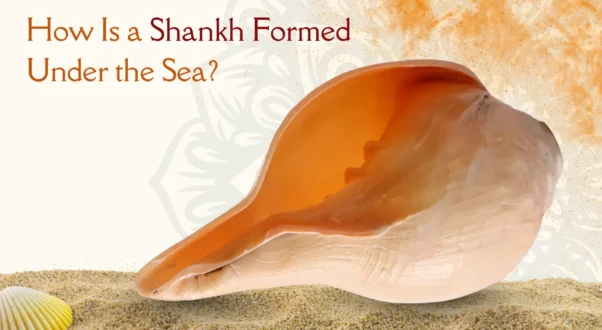
How Is a Shank Formed Under the Sea? Real Science Behind the Sacred Shell
The religious output and spiritual depth connect Indian tradition with rituals to the Shank (Conch shell). The significance of purity, prosperity and Vastu remedies is only one of the many Shank Benefits. It’s a sacred object that resonates with divine energy and positivity into the surroundings when placed or blown. This is what makes Sea Shank beyond its revered place in Hindu culture and mythology.
Let’s dive into the blog—exploring the real science behind the formation of Natural Shank—its origin, types and benefits.
What Is a Shank?
Obviously, you are not new to the term, but still, a conch shell is a sea-dwelling gastropod. It belongs to the family of marine shells, although it is used for protection and mobility. Over time, it turns into a spiral structure and hardens with a layer of calcium carbonate.
It’s what we recognize as a sacred conch in temples and homes. In Sanskrit, the word Shank is referred to as a conch that holds divine sound. It symbolizes deep, powerful resonance that is believed to be the cosmic sound of “Om”.
The Science: How Is a Shank Formed Under the Sea?
Of course, Shank isn’t man-made but occurs naturally beneath the sea surface by sea snails. It’s a continuous biological process that takes time.
Mollusc Secretions and Shell Formation
The creature that lives inside the conch and creates it, known as a mollusc, reacts with calcium carbonate. It hardens with time and forms protective layers on the mollusc’s body in a signature spiral or coiled shape.
Torsion and Spiral Growth
Natural Shanks are of spiral shape and are formed under a process known as torsion, which is natural. It mostly leads to left-turning or right-turning spirals, due to the mollusc’s body rotating during development. This twist or spiral formation is genetically determined, which gave rise to Different Types of Shank.
Seawater Minerals Enhance Structure
Typically, conch shells absorb minerals like magnesium and aragonite from seawater. This makes it strong and resonant in nature. The natural compounds and reactions give the shank hardness and even a distinctive sound quality.
Different Types of Shank Found in Nature
Scroll down and check out the Different Types of Shank. The classification is found across the world, but in India, it is primarily connected with spiritual significance, such as

Vamavarti Shank (Left-Turning)
This is the most common natural seashell that is left-handed. It’s mainly used for blowing during puja and sacred rituals. The vamavarti shankh is associated with lord Vishnu and produces the sacred Om sound.
Dakshinavarti Shank (Right-Turning)
It’s the most extreme and rarest Natural Shank with the right side spiral direction. The Dakshinvarti Shank are highly auspicious, lucky and bring fortune because they are associated with Goddess Lakshmi; unlike the Vamavarti Shankh, it’s not blown that usually, but kept for wealth and prosperity rituals.
Gaumukhi Shank
This is a unique shank that’s shaped like a cow’s mouth (mukh). It’s used for ritual bathing and purification. For pouring sacred water on deities, the Gaumukhi shank is used in temples and pujas.
Heeramani or Moti Shank
This shank is pearl white and smoother in texture—resembles the mother of pearl. The Shank is rare and associated with divine blessing & purity.
Kauri Shank
It’s smaller in size and mainly used in tantra rituals and astrological remedies, spiritual usage and benefits.
Shank Benefits: Scientific and Spiritual Insights
Let’s now talk about the Shank Benefits that extend beyond religious belief and touch. Studies say Shankh Sound affects deeply the body, mind and environment as-
Sound Therapy and Vibration
Shank blowing generates low-frequency sound waves. It’s clear that it’s within the nasal passages, strengthens the lungs and stimulates the nervous system. The vibration impacts the environment and reduces harmful microbes. It thus purifies the air.
Mental and Emotional Calm
The deep sound of Om helps promote mental clarity and emotional stability. It’s aligning chakras—the Ajna and Vishuddha chakras.
Financial and Energetic Benefits
Typically, the dakshinavarti shank is meant to attract wealth and auspiciousness to keep puja energy locked. The use and presence of the shankh neutralize Vastu doshas and uplift the surroundings.
Vastu Benefits
Shank’s placement brings harmony and invites calmness.
How to Identify the Original Shank
You may easily find fake artificial shanks in the market. If you are in doubt about how to identify the Original Shank, follow the hacks-
Check the Texture
Typically, the natural shanks have ridges, irregularities and grainy texture.
Smell Test
Natural sea Shank may have a mild oceanic or salty smell.
Weight and Sound
The natural conch is heavier, all because of its natural mineral composition. This gives a metallic or resonant sound.
Color
Original shanks are off-white, beige or pearl tine but not purely white. This is all because of discoloration and signs of ageing.

The Mystery of the Shank Sound
The precise mystical sound of the shank is produced when it is blown. Is there a sacred belief or science behind? Typically, the shankh works like a wind instrument; thus, when air is blown, it vibrates within the spiral cavity, producing a frequency. That ranges between 100 and 300 Hz. The sound is similar to deep chanting, like Om.
The Final Verdict
Natural Shank is a marvel of marine biology that signifies traditions. Its sacred sound and benefits make them intertwined in science and spirituality. The Different Types of Shanks represent the beauty of nature and divine energy, holding sacred beliefs. From centuries of wisdom to mighty forces of oceans, the Sea Shanks have deep connections.
FAQs
1. What are the different types of shank?
The major types include:
- Vamavarti Shank (left-spiral, used for blowing)
- Dakshinavarti Shank (right-spiral, associated with wealth)
- Gaumukhi Shank, Heeramani Shank, and Kauri Shank, each having unique shapes and uses in rituals and Vastu.
2. What are the benefits of keeping a shank at home?
Shanks bring spiritual energy, purify the air, improve lung health, and remove Vastu doshas. They are believed to attract wealth and peace, especially when placed correctly according to Vastu.
3. How to identify an original shank?
Original shanks have a natural texture, an oceanic smell, a heavier weight, and a metallic sound. Avoid perfectly white or smooth shanks, as they’re usually synthetic.
4. What causes the sound in a shank when blown?
When you blow air into the shank, it vibrates within its spiral cavity, creating low-frequency sound waves. These vibrations resonate with the human body’s energy system, promoting calm, clarity, and environmental purity.
Explore insights from Kalari Warriors, blending ancient Kalaripayattu traditions with spiritual craftsmanship to enrich your life and rituals.




